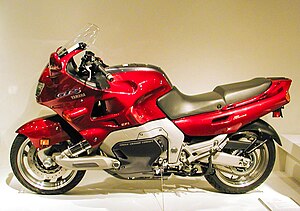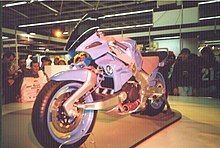Yamaha GTS 1000
| Yamaha | |
|---|---|
 Chassis number 4BH |
|
| Yamaha GTS 1000 | |
| Manufacturer | Yamaha |
| Production period | 1993 to 1997 |
| class | motorcycle |
| design type | Sports Tourer |
| Motor data | |
| water-cooled four - stroke engine with 4 cylinders | |
| Displacement (cm³) | 1003 |
| Power (kW / PS ) | 74/100 at 9,000 min -1 |
| Torque ( N m ) | 101.8 at 6,500 min -1 |
| Top speed ( km / h) | 215 |
| transmission | 5-speed, multi-disc clutch in an oil bath |
| drive | Chain drive with open roller chain |
| Brakes | front: disc brake Ø 330 mm, rear: disc brake Ø 282 mm |
| Wheelbase (mm) | 1495 |
| Seat height (cm) | 79 |
| Empty weight (kg) | 271 (282 kg with ABS) |
| Previous model | none |
| successor | none |
The Yamaha GTS 1000 is a motorcycle from the Japanese manufacturer Yamaha . The Sporttourer is the only series-produced motorcycle with axle steering to date . Yamaha presented its new flagship at the IFMA in Cologne in 1992 .
development
Yamaha started thinking about this as early as 1989 and constructed the “Morpho” study. The advance development was done by James Parker, who received a patent on a double-pivot steering on July 2, 1985, Yamaha acquired the patent rights. The sports tourer was produced from 1993 to 1997.
technology
The stub axle steering is a seldom used type of front wheel control on motorcycles. Trials and series production with wheel hub steering (steering pin in the center of the wheel hub) have been carried out in the motorcycle sector; pure kingpin steering has so far not got beyond the experimental stage, like the Elf racing machines from 1978 to 1988. The first kingpin in series was with the model Yamaha GTS 1000 (1993 -1997) used. With the Yamaha, two wishbones installed lengthways one above the other transmit the forces that occur, a shaft with two cardan joints and a sliding joint transmits the steering movement. The shock absorber engages the lower trailing arm and is supported on the frame - Yamaha called it the Omega frame.
Test and criticism
A test comparison showed that the unsprung mass on the front wheel at 31.6 kg was much higher than a conventional telescopic fork at 21.5 kg. Due to the design, this required high compression damping. The kingpin steering of the Yamaha was only able to achieve advantages in this test with a higher braking compensation. The caster was measured at 100 mm and the steering head angle at 66 degrees, the spring travel was 116 mm at the front and 130 mm at the rear.
The chassis received criticism; the theoretical advantage of the stub axle steering could not be seen in the test drive. The front tire, which was too wide in size 130/60 ZR 17, was heavily criticized. Nevertheless, Yamaha “didn't put on the shoe” and delivered the motorcycle with this tire size until the end of production, despite the suggestion for improvement to 120/70 ZR 17. Ulf Böhringer found the chassis a disappointment:
“The motorcycle appears to be extremely unwilling to turn when it is driven briskly on undulating ground. The front wheel follows every joint, every lane marking, and heavy work is done on the handlebars to keep the big bike on course. In principle, it is not easy to force the GTS into an inclined position or even to bend it further in a tightening curve. "
In contrast to the "revolutionary concept" of the front suspension, Yamaha stayed with the swing arm on the rear wheel on the state of the art. The five-valve engine of the Yamaha FZR 1000 with three-way catalytic converter , whose high fuel consumption was criticized, acted as the drive source of the sports tourer, for the German market from 107 kW (145 PS) to 72 kW (98 PS) :
“When driving on the highway, gasoline consumption can rise to over ten liters per 100 kilometers, but when the gasoline control lights up, a good 60 kilometers are still possible with moderate throttle. The GTS is definitely not a machine for do-it-yourself screwdriving. The dismantling of the six-part paneling alone makes nervous fingers desperate. "
A less touring-friendly chain drive was built into the secondary drive. The motorcycle was available with an anti-lock braking system at an additional cost ; the model name was then Yamaha GTS 1000 (A). In Germany, 1,369 copies are said to have found a buyer. Remaining stocks were sold after the end of series production until 1999.
literature
- Axel Koenigsbeck, Hans J. Schneider, Peter Abelmann: Yamaha . Schneider Text Edition 2004, ISBN 0-9541746-0-7 .
Web links
Remarks
- ↑ For the trade press it was the "creativity of the Yamaha engineers". See Koenigsbeck, p. 174
- ↑ In test reports, the motorcycle received top marks (MOTORRAD test 1993–1997)
Individual evidence
- ↑ Technical data according to Koenigsbeck et al. P. VII
- ↑ Koenigsbeck, p. 174
- ↑ Jürgen Stoffregen: Motorcycle technology: Basics and concepts of engine, drive and chassis . Vieweg Verlag, Braunschweig 2010, ISBN 978-3-8348-0698-7 , p. 304 .
- ↑ Peter Mund: Yamaha GTS 1000. In: bma, edition 10/2013. April 1, 2002, accessed February 27, 2015 .
- ↑ US 4526249
- ↑ Thomas Krens, Ultan Guilfoyle, Sarah Botts: The Art Of The Motorcycle . Guggenheim Museum New York Publications, New York 2001, ISBN 978-0-8109-6912-4 , pp. 375 .
- ↑ https://silodrome.com/wp-content/uploads/2013/12/Yamaha-GTS-1000-Motorcycle-Brochure.jpg X-ray representation of the motorcycle
- ↑ Jürgen Stoffregen: Motorcycle technology: Basics and concepts of engine, drive and chassis . Vieweg Verlag, Braunschweig 2010, ISBN 978-3-8348-0698-7 , p. 305 .
- ↑ motorcycle . No. 18 , August 21, 1993, p. 14-24 .
- ↑ MOTORRAD Test 1996, p. 28.
- ↑ Koenigsbeck, p. 176.
- ↑ Ulf Böhringer: Moderate fine tuning. In: Süddeutsche Zeitung . July 31, 1993, accessed February 25, 2015 .
- ^ A b Peter Limmert: Stupid run. In: Motorrad , issue 23/1997. October 27, 1997, accessed February 25, 2015 .
- ↑ MOTORRAD Test 1993, p. 56.
- ↑ Klaus Herder: From flop to sweetheart. In: Motorrad , issue 10/2013. April 25, 2013, accessed October 2, 2013 .
- ↑ Koenigsbeck, p. 179.
